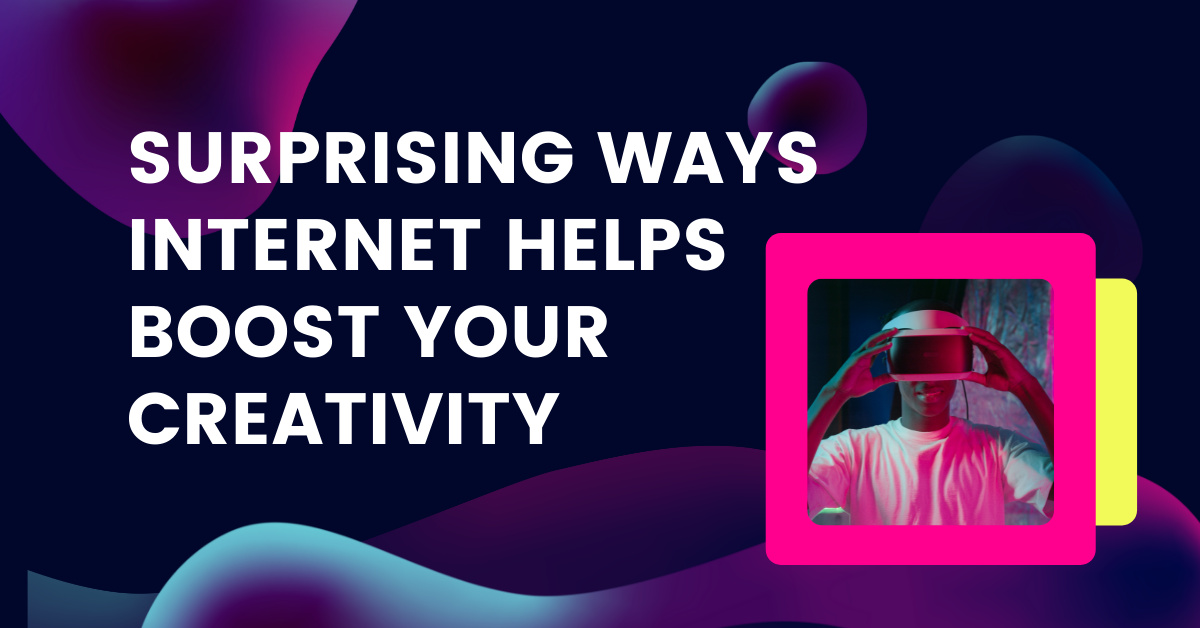The internet is a vast and ever-growing resource for information, entertainment, and connection. But did you know that it can also help boost your creativity? According to recent studies, using the internet can actually help increase cognitive flexibility and divergent thinking – two key components of creativity. In this blog post, we will discuss how the internet can help improve your creativity and provide some tips on how to get the most out of it!

Information Supply
So how can the internet help increase your creativity? For one, it provides a never-ending supply of information and ideas to draw from. Whether you’re looking for inspiration for a new project or just trying to learn more about a particular topic, the internet is a wealth of knowledge. But it’s not just the amount of information that’s important – it’s also the diversity. When you expose yourself to a variety of perspectives and ideas, it helps your mind to “think outside the box” and come up with new and innovative solutions.

Creativity Collaboration
Another way the internet can help boost your creativity is by providing a platform for collaboration. With so many people online, it’s easier than ever to connect with others who share your interests and can help you achieve your creative goals. Whether you’re looking for a sounding board for new ideas or feedback on a work in progress, the internet can help you find the people you need to make your project a success.
So how can you make the most of the internet’s potential to boost your creativity? Here are a few tips:
1. Search Engines
Make use of search engines and online directories: When you’re looking for inspiration or information, don’t be afraid to use search engines and online directories. By exposing yourself to a variety of sources, you’ll be more likely to come up with original ideas.
2. Communities & Forums
Join online communities and forums: There are online communities and forums for just about every interest imaginable. These can be a great way to connect with like-minded people and get feedback on your work.
3. Social Media
Make use of social media: Social media platforms like Twitter and Facebook can be great resources for finding new and interesting content. They can also help you connect with other creatives and get feedback on your work.
By making use of the internet’s vast resources, you can help boost your creativity and come up with original and innovative ideas. So don’t be afraid to surf the web – you never know what you might find
4. Have an End Goal
The first step of the Creative Problem Solving (CPS) methodology is to “clarify and identify the problem”. This is an important step in being creative. To have a problem to solve, or question to answer, is the main step to successfully and creatively accomplishing your end-goal.
A useful way to do this is to use the 5 Whys method that Sakichi Toyoda introduced to Toyota in the early 1900s. When you ask yourself “Why do I want to do this?”, the first answer will be pretty broad, and won’t get to the heart of the problem. So keep asking yourself why another three or four times. This should be enough to help you dig to the root of the problem to pinpoint what you’re working on.
As an example from Wikipedia:
- Why? – The battery is dead. (first why)
- Why? – The alternator is not functioning. (second why)
- Why? – The alternator belt has broken. (third why)
- Why? – The alternator belt was well beyond its useful service life and not replaced. (fourth why)
- Why? – The vehicle was not maintained according to the recommended service schedule. (fifth why, a root cause)
Once you’ve figured out the root cause, you can reword this into a creative challenge. In this case that could be: How can we ensure more vehicles are maintained according to the recommended service schedule? Each challenge you articulate should focus solely on one problem, but should be broad enough not to limit your creativity.
These strategies can be delved into with a paper notepad, but there are other online tools that can help to visualize each of the whys and challenges more clearly. You can build three stunning mind maps for free using MindMeister. Lino (iOS, Android) can help you play around with your ideas with digital Post-It notes. And Microsoft OneNote (read our introduction) is an easy, visual way to organize your thought process.
5. Know Your Area
Unfortunately, solving a creative challenge without having an in depth knowledge of the relevant area(s) is unlikely to result in much creative success.
This is where research and rapid skill acquisition abilities are invaluable. I’ve written before about how you can bypass Malcolm Gladwell’s 10,000-hour rule, and acquire valuable skills much more quickly. In essence, you’ll need to:
- Create a feedback loop to spot your weaknesses and learn from them
- Use “Deliberate Practice” to methodically and strategically eliminate those weaknesses
- Start teaching others what you learn, as this helps you to more fully grasp the concepts
So, if you’re struggling to find a solution to your problem, start learning as much as you can about the area. As your knowledge expands, you’ll be able to see different ways to defeat the problem. To help with this, finding online courses on sites such as Lynda or Coursera will be extremely helpful. As will finding YouTube channels and blogs on those topics, and then using these to keep up to date with that area of expertise.
6. Expand Your Horizons
To move up the levels in creativity, you must expand your horizons further than simply the area in which your creative challenge lies. As you expand your knowledge into other areas of interest, from learning photography, to speaking another language, the angles from which you can attack your creative challenge increase exponentially.
Naturally, the more areas you delve into, the more solutions you will be able to conjure up from your myriad interests. This isn’t to say you need to master each of these interests. Simply having a basic grasp of a diverse range of fields is a huge boost to your creativity. Imagine the incredible results that could come from a programmer who also has an interest in illustration, photography, and literature, versus a programmer whose only hobby is reading the tech news. It’s at this intersection between myriad fields of interest where some of the most exciting creative breakthroughs can happen. And so to reach this level of creativity, create some free time for yourself, allow for serendipity, listen to the most random audio courses, and follow your curiosity.
When it comes to being creative, the internet provides a wealth of resources that can help. From a never-ending supply of information, to a platform for collaboration, the internet can help you in more ways than one. So make use of it and see how it can help improve your creativity!
Conclusion
So far we’ve talked about how the internet can help you boost your productivity, but what about creativity? Surprisingly, the internet can also be a great tool for helping to unleash your creative side. For example, Artmeet.my is an online community of artists from all over the world who come together to share their work, learn from each other, and collaborate on new projects. By joining this or another online community of creatives, you can get feedback and inspiration from others who are just as passionate about art as you are. You can also find new sources of inspiration by browsing artwork on websites like Pinterest or Instagram. What’s more, using online tools like Photoshop or Illustrator to create your own digital art and can upload them onto your own profile here at Artmeet.my

